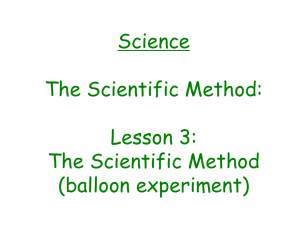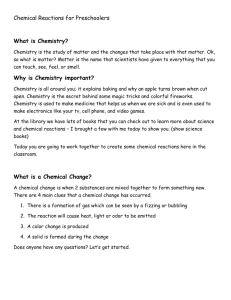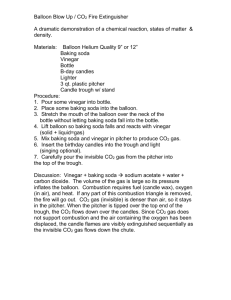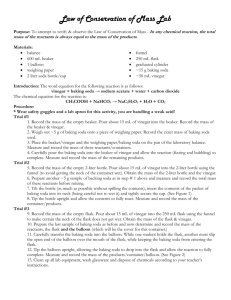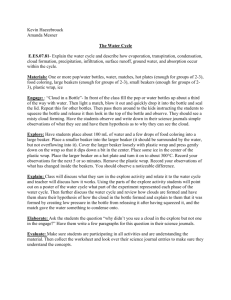Conservation of Matter Lab Discussion: In this lab, you will
advertisement
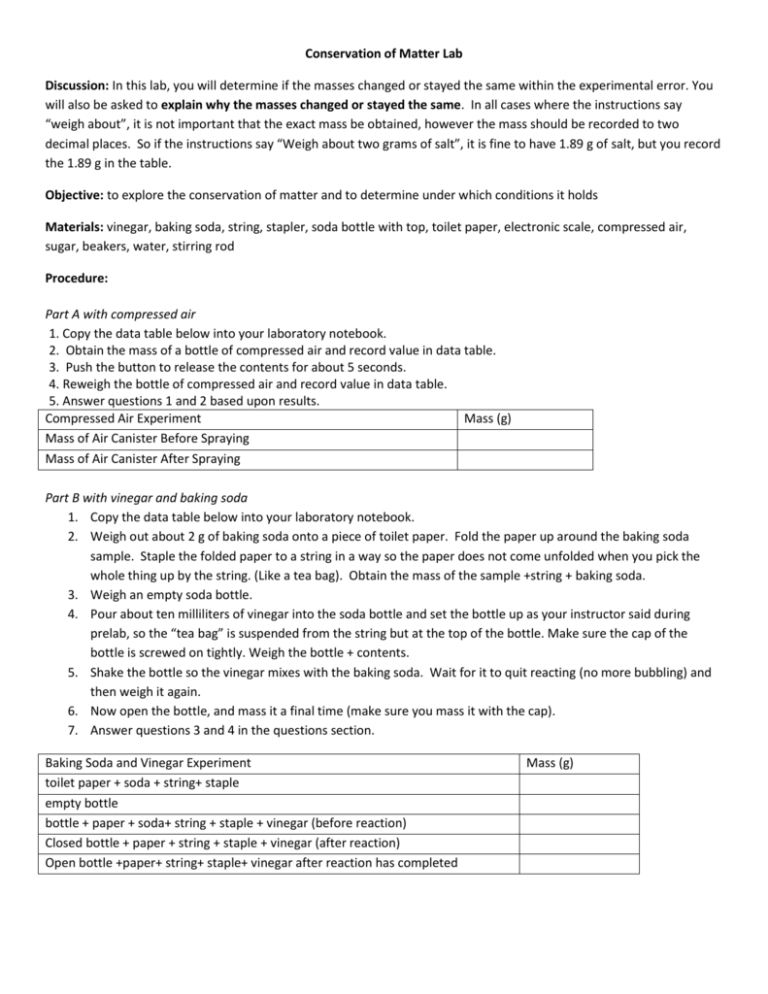
Conservation of Matter Lab Discussion: In this lab, you will determine if the masses changed or stayed the same within the experimental error. You will also be asked to explain why the masses changed or stayed the same. In all cases where the instructions say “weigh about”, it is not important that the exact mass be obtained, however the mass should be recorded to two decimal places. So if the instructions say “Weigh about two grams of salt”, it is fine to have 1.89 g of salt, but you record the 1.89 g in the table. Objective: to explore the conservation of matter and to determine under which conditions it holds Materials: vinegar, baking soda, string, stapler, soda bottle with top, toilet paper, electronic scale, compressed air, sugar, beakers, water, stirring rod Procedure: Part A with compressed air 1. Copy the data table below into your laboratory notebook. 2. Obtain the mass of a bottle of compressed air and record value in data table. 3. Push the button to release the contents for about 5 seconds. 4. Reweigh the bottle of compressed air and record value in data table. 5. Answer questions 1 and 2 based upon results. Compressed Air Experiment Mass (g) Mass of Air Canister Before Spraying Mass of Air Canister After Spraying Part B with vinegar and baking soda 1. Copy the data table below into your laboratory notebook. 2. Weigh out about 2 g of baking soda onto a piece of toilet paper. Fold the paper up around the baking soda sample. Staple the folded paper to a string in a way so the paper does not come unfolded when you pick the whole thing up by the string. (Like a tea bag). Obtain the mass of the sample +string + baking soda. 3. Weigh an empty soda bottle. 4. Pour about ten milliliters of vinegar into the soda bottle and set the bottle up as your instructor said during prelab, so the “tea bag” is suspended from the string but at the top of the bottle. Make sure the cap of the bottle is screwed on tightly. Weigh the bottle + contents. 5. Shake the bottle so the vinegar mixes with the baking soda. Wait for it to quit reacting (no more bubbling) and then weigh it again. 6. Now open the bottle, and mass it a final time (make sure you mass it with the cap). 7. Answer questions 3 and 4 in the questions section. Baking Soda and Vinegar Experiment toilet paper + soda + string+ staple empty bottle bottle + paper + soda+ string + staple + vinegar (before reaction) Closed bottle + paper + string + staple + vinegar (after reaction) Open bottle +paper+ string+ staple+ vinegar after reaction has completed Mass (g) Part C Sugar in water 1. Copy the data table into your laboratory notebook. 2. Weigh two clean, dry beakers. Record the mass of each beaker in the data table. Weigh out about 3.0 grams of sugar in one beaker and about 20.0 grams of water (this is about 20.0 mL) in the second beaker. 3. Place the glass stirring rod provided into one of the beakers. Weigh the stirring rod and two small beakers (with contents) all at once and record this in the data table as the Measured Total Mass Before Mixing. 4. Pour the water from the second beaker into the sugar beaker and stir the contents with the coffee stirrer until the sugar dissolves. Don’t set the stirrer onto the table. 5. Place both small beakers and the stirring rod back into the plastic dish. Use the balance and determine the total mass and record it as Measured Total Mass After Dissolving. 6. Answer questions 5 and 6 in questions section. Sugar in Water Experiment Mass (g) Beaker 1 Beaker 1 + Sugar Sugar Beaker 2 Beaker 2 + Water Water Measured Total Mass Before Mixing Measured Total Mass After Dissolving Questions: Record number of question and answer in your laboratory notebook. 1. Did the mass of the canister increase, decrease, or remain the same? 2. Explain why you think this occurred with the compressed air experiment. 3. Within experimental error, was the mass after the reaction larger, smaller or the same compared to just before the reaction? 4. Why do you think this occurred? 5. Within experimental error (such things as the drift of the balance and your spilling), was the total mass after mixing larger, smaller or the same as the total mass before mixing? 6. Why you think this occurred with the sugar and water test? Conclusion (write one which includes observations from parts A, B, and C): From this laboratory experiment, I know that a gas has ____ because _______. I know that dissolving (does or does not change the mass) because _____. This leads to the conclusion that the conservation of matter ______. When completed with your experiments, record your values on the class papers for each experiment.


